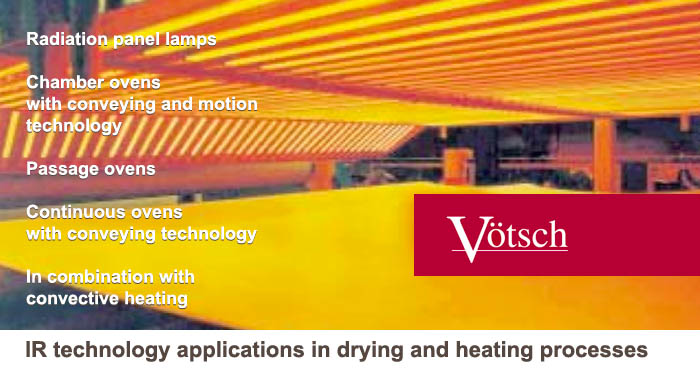Infrared system IR
Infrared systems for industrial drying and heating processes.

Infrared (IR) is the radiation component in sunlight that provides us with heat.
Infrared technology involves rapid heating which transmits energy at the speed of light in the form of electromagnetic radiation without any direct contact or transmission medium.
This makes IR heating particularly suitable for especially sophisticated.
A variety of system concepts is available for IR technology applications in drying and heating processes:
- Radiation panel lamps
- Chamber ovens (special designs also available with conveying and motion technology)
- Passage ovens
- Continuous ovens with conveying technology
- In combination with convective heating
Application – Application examples for IR Lamps
Panel lamps
- Embossing equipment
- Paint drying
- Preliminary gelation
Radiation frames in ovens
- Paint drying
- Powder paint drying
- Post-curing of plastic coatings
- Heating-up zones
Passage oven
- Drying fibres at a high passage speed
- Surface tempering of plastic pipes
Continuous oven
- Paint drying
- Rapid surface heating of product being treated
- Preheating zone in combination with series-connected hot air zones
IR Lamp types
Lamps with different characteristics are used, depending on the IR compatibility of the product to be heated or dried. The IR lamps to be employed are always differentiated on the basis of the wavelengths emitted.
Long wave infrared lamp
- Operating temperature: 300°C to 700°C.
- Max. emission at wavelengths: > 3.5 μm.
- Application technology characteristics: high mechanical strength, relatively long heating and cooling period.
Medium Wave Infrared Lamp
- Operating temperature: 700°C to 1,000°C.
- Max. emission at wavelengths: >2 μm/
- Application technology characteristics: short heating and cooling periods, high radiation efficiency.
Short wave infrared lamp
- Operating temperature: 1,400°C to 3,000°C.
- Max. emission at wavelengths: >0.8 μm/
- Application technology characteristics: short heating and cooling periods.
